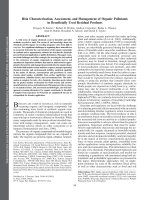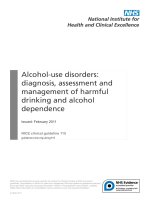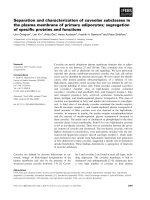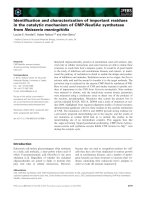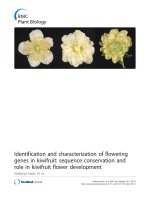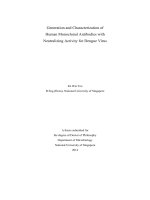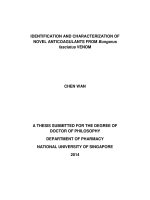Assessment and characterization of soil of pandariya block in Kabeerdham district, Chhattisgarh, India
Bạn đang xem bản rút gọn của tài liệu. Xem và tải ngay bản đầy đủ của tài liệu tại đây (314.96 KB, 7 trang )
Int.J.Curr.Microbiol.App.Sci (2017) 6(6): 1378-1384
International Journal of Current Microbiology and Applied Sciences
ISSN: 2319-7706 Volume 6 Number 6 (2017) pp. 1378-1384
Journal homepage:
Original Research Article
/>
Assessment and Characterization of Soil of Pandariya Block in
Kabeerdham District, Chhattisgarh, India
Dileshwar Prasad*, Narendra Swaroop, Tarence Thomas,
Arun A. David and P. Smriti Rao
Department of Soil Science and Agricultural Chemistry, Sam Higginbottom University of
Agriculture, Technology and Sciences- 211007 Allahabad, U.P., India
*Corresponding author
ABSTRACT
Keywords
Pandariya Block,
Depth,
Chemical
Properties, Soil
Article Info
Accepted:
19 May 2017
Available Online:
10 June 2017
A survey of chemical properties of soil of Pandariya Block of Kabirdham
District, Chhattisgarh India was carried out in year 2016-17. 27 Soil
samples were collected at a depth of 0-15, 15-30 and 30-45 cm from 9
Village- Baghraytola (V1), Amarpur (V2), Chhirpani (V3), Jhingradongri
(V4), Kodwagodan (V5), Vicharpur (V6), Ravan manjholi (V7), Gudha (V8),
Malkachhra (V9). Soil sample were analysed for pH, EC, OC and N, P, K,
Zn and S. The value of pH, EC, OC is found in ranges from 6.3 to 7.8,
0.11- 0.68 dSm-1, 0.13 to 0.60 per cent respectively. and N, P, K, Zn, S is
found in ranges from 180.3 to 288 kg ha-1, 10.4 to 20.2 kg ha-1, 129.2 to
205.2 kg ha-1, 0.87 to 1.24 ppm, 10.5 to 18.4 ppm respectively. The pH is
neutral, Electrical Conductivity is normal. The status of organic carbon
percent and nitrogen is low to medium, the status of phosphorus, potassium
and sulphur is medium in soil, and Zn is medium to high.
Introduction
Soil is the basic resource for agriculture and
its proper management is essential to sustain
agricultural production and maintain soil
productivity. Soil testing is one of the best
available tools, to ascertain the physical
characteristics & nutrient status of a field so
as to assess the fertilizer requirements for a
crop or a cropping system or for knowing the
reclamation requirements if the soil is saline
or sodic in nature. Fertilizer application based
on soil tests is the best available approach for
harvesting the economically viable potential
yields of crops by increasing input use
efficiency and maintaining soil health (Singh
and Brar, 2005). Soil test-based fertility
management is an effective tool for increasing
productivity of agricultural soils that have
high degree of spatial variability resulting
from the combined effects of physical,
chemical or biological processes (Goovaerts,
1998). The production of rice crop is more in
the Central part of India. Chhattisgarh is
situated in the central part of India. The state
of Chhattisgarh, with Raipur as its capital,
came into existence on 1st November, 2000
by separation of 16 districts of Chhattisgarh
region from Madhya Pradesh. At present 27
districts
are
there
in
Chhattisgarh.
1378
Int.J.Curr.Microbiol.App.Sci (2017) 6(6): 1378-1384
Chhattisgarh is situated between 17-23.70 N
latitude and 80.40-83.380 E longitude in
Central eastern part of India. The total
geographical area of the state is 136.03
thousand sq. km.
as the productive capacity of different soils,
varies.
Geographically, Chhattisgarh is divided into
three distinct land areas viz.
Kanhar (clayey)
The following types of soils are found in
Chhattisgarh (Tripathi and Bhardwaj, 2016):
A low-lying deep bluish black soil with high
moisture retention capacity. It is well suited
for rabi crops, particularly wheat.
Chhattisgarh Plains,
Bastar Plateau and
Matasi (sandy loamy)
Northern Hill Zones.
The state receives annual rainfall ranging
from less than 1200 mm to greater than 1600
mm in different areas. The border of
Chhattisgarh is touched by the states Uttar
Pradesh in the North, Bihar in the North East,
Orissa in the East, Andhra Pradesh in the
South and South East, Maharashtra in South
West and Madhya Pradesh in the West. Paddy
is the main crop of the state and due to
abundance of production of paddy
Chhattisgarh was known as 'Rice Bowl of
Central India.'
A vast region of Chhattisgarh is covered by
red & yellow soil. There are a number of
types of soil found in Chhattisgarh area but
there are four major types namely Kanhar,
Matasi, Dorsa and Bhata, which cover major
portion of the total land area. The red color of
soil is generally related to unhydrated ferric
oxide, and partially hydrated ions oxides. The
yellow color in soil is also due to oxides of
iron. The soils of the region are deficient in
important mineral nutrients like nitrogen,
phosphorous, lime and potash, which are
concentrated in the lower parts of the soil
layer. However, the tropical red and yellow
soils or the red sandy soils of the region
possess texture suitable for growing crops.
For the state as a whole, the predominant soil
type is red and yellow loamy Soil. The
percolation/water retention capacity, as well
This is a yellow sandy soil, with an admixture
of clay. It has limited moisture retention
capacity. Though used for paddy.
Dorsa (clay-loam)
This type of soil is intermediate in terms of
soil moisture retention between kanhar and
matasi. This is best described as loamy, and is
a color between brown and yellow.
Bhata (laterite)
This soil is a coarse-textured, red sandygravelly soil, found on upland tops. It is
deficient in minerals and other productivity
enhancing nutrients.
Materials and Methods
Site Detail
Pandariya is a Block located in Kabeerdham
district in Chhattisgarh. Placed in rural region
of Chhattisgarh, it is one among the 4 blocks
of Kabeerdham District (Fig. 1). Pandariya is
located at 22°14′N 81°25′E to 22.23°N
81.42°E.) normal rainfall is 1450.0 mm and
average rainfall 1241.0 mm. The region
generally experiences hot, sub humid climate,
having average rainfall of 1157.1 mm. It has
an average elevation of 348 m (1,142 ft).
1379
Int.J.Curr.Microbiol.App.Sci (2017) 6(6): 1378-1384
Sampling and analysis
Electrical conductivity (EC)
The 27 soil samples were collected with
different depths (0-15cm, 15-30 cm, 15-30
cm) from 9 Village- Baghraitola (V1),
Amarpur (V2), Chhirpani (V3), Jhingradongri
(V4), Kodwagodan (V5), Vicharpur (V6),
Ravan manjholi (V7), Gudha (V8),
Malkachhra (V9). The pH was determined in
1:2 soil water suspensions using Digital pH
Meter (Jackson 1958). The EC was
determined in 1:2 soil water suspensions
using Digital Conductivity Meter (Wilcox
1950). The organic carbon was determined by
Rapid Titration Method (Walkley 1947). The
available nitrogen (kg ha-1) in soil is
determined
by
alkaline
potassium
permanganate method (Subbiah and Asija
1956).
The lowest value of electrical conductivity
found in Baghraytola at depth (15-30 cm)
0.11 dSm-1 and Rawan manjholi at depth (3045 cm) 0.11 dSm-1 and highest value in
Chhirpani at depth (30-45cm) 0.68 dSm-1.
The EC was found to be non-significant at
different depths and villages.
Organic carbon (OC) percent
The lowest value of organic carbon percent is
found in soil of Kodwagoda at depth (30-45
cm) 0.13 per cent and highest value in soil of
Gudha at depth (0-15cm) 0.60 per cent. The
OC (%) was found to be significant at
different depths and villages.
Available nitrogen (kg ha-1)
The available phosphorous was extracted
from soil by 0.5 M NaHCO3 (pH 8.5)
solution. Phosphorous in the soil extract is
determined
colorimetrically
using
a
Photoelectric Colorimeter after developing
molybdenum blue colour (Olsen et al., 1954).
The exchangeable potassium is extracted from
1N NH4OAC (pH 7.0) and K was determined
by Flame Photometer (Toth and Prince 1949).
The available sulphur (ppm) by turbidimetric
method (Bardsley and Lancaster, 1960). The
available zinc (ppm) was determined by
suggested method of Shaw and Dean (1952)
and Holmes (1945).
Results and Discussion
Soil pH
The Lowest value of nitrogen is found in soil
of Amarpur at depth (30-45 cm) 180.3 kg ha-1
and highest value in soil of Ravan manjholi at
depth (0-15cm) 288 kg ha-1. The available
nitrogen (kg ha-1) was found to be significant
at different depths and villages.
Available phosphorus (kg ha-1)
The value of available phosphorus (kg ha-1) is
found in varied from 10.4 to 20.2 kg ha-1.The
lowest value of phosphorus is found in soil of
Chhirpani at depth (30-45 cm) 10.4 kg ha-1
and highest value in soil of Kodwagodan at
depth (0-15cm) 20.2 kg ha-1. The available
phosphorus (kg ha-1) was found to be nonsignificant at different village but found to be
significant at different depths.
Available potassium (kg ha-1)
The Lowest value of pH found in Kodwagoda
at depth (30-45 cm) 6.3 and highest value in
Gudha at depth (15-30cm and 30-45cm) 7.8
and Malkachhra at depth (15-30cm) and pH
was found to be non-significant at different
depths and villages.
The lowest value of potassium is found in soil
of Baghraitola at depth (30-45 cm) 129.2 kg
ha-1 and highest value in soil of Vicharpur at
depth (0-15cm) 205.2 kg ha-1. The available
potassium (kg ha-1) was found to be nonsignificant at different depths and villages.
1380
Int.J.Curr.Microbiol.App.Sci (2017) 6(6): 1378-1384
Table.1 Rating chart for soil test values and their nutrient indices based on the specific rating
chart modified from Brajendra et al., (2014)
Soil property
Soil pH
Unit
pH unit
< 6.0 (Acidic)
Range
6.1-8.0(Neutral)
Electrical
conductivity
Organic carbon
Available nitrogen
(N)
Available
phosphorus (P2O5)
Available
potassium (K2O)
Available sulphur
(S)
Available zinc
(Zn)
dSm-1
<1.0 (Normal)
1.0-2.0 (Critical)
Percent
kg ha-1
<0.5 (Low)
<280 (Low)
0.5-0.75(Medium)
280-560 (Medium)
>8.0
(Alkaline)
>2.0
(Injurious)
>0.75 (High)
>560 (High)
kg ha-1
<10 (Low)
10-25 (Medium)
>25 (High)
kg ha-1
<110 (Low)
110-280 (Medium)
>280 (High)
ppm
<10 (Low)
10-30 (Medium)
>30 (High)
ppm
<0.6 (Low)
0.6-1.0 (Medium)
>1.0 (High)
Fig.1 District and Block map of Kabeerdham District
Study Area
1381
Int.J.Curr.Microbiol.App.Sci (2017) 6(6): 1378-1384
Table.2 Analysis results of chemical parameters of soil samples of Pandariya Block in
Kabeerdham District, Chhattishgarh
Village
Baghraitola
(V1)
Amarpur
(V2)
Chhirpani
(V3)
Jhingradongri
(V4)
Kodwagodan
(V5)
Vicharpur
(V6)
Ravan
manjholi
(V7)
Gudha
(V8)
Malkachhra
(V9)
Depth
in
cm
pH
EC
(dSm-1)
OC
in
%
0-15
15-30
30-45
0-15
15-30
30-45
0-15
15-30
30-45
0-15
15-30
30-45
0-15
15-30
30-45
0-15
15-30
30-45
0-15
15-30
7.0
7.0
7.5
7.3
7.2
6.4
7.4
7.0
6.8
6.5
6.4
7.1
7.2
7.2
6.3
7.4
7.5
7.3
6.8
7.0
0.6
0.11
0.38
0.59
0.4
0.62
0.38
0.32
0.68
0.48
0.31
0.18
0.28
0.4
0.41
0.41
0.18
0.58
0.54
0.12
30-45
0-15
15-30
30-45
0-15
15-30
30-45
7.5
7.0
7.8
7.8
7.0
7.8
7.1
0.11
0.14
0.16
0.16
0.32
0.24
0.38
Nutrient
0.22
0.21
0.17
0.60
0.36
0.31
0.42
0.26
0.25
0.62
0.43
0.21
0.35
0.31
0.13
0.22
0.20
0.19
0.39
0.37
N
(kg ha-1)
235
208.9
205.4
198.1
187.2
180.3
210.8
205.1
198.26
207.6
185.2
181.3
214.4
195.23
189.23
198.53
186.3
182.3
288
252.1
P
(kg ha-1)
16.1
11.8
11.6
18.2
16.8
11.4
18.5
12.2
10.4
18.7
15.8
15.8
20.2
16.4
11.2
18.2
15.3
14.8
17.4
17.2
K
(kg ha-1)
172.7
142.2
129.2
175.7
168.4
164.4
185.7
150.2
148.7
190.2
161.2
150.4
188.4
178.4
174.5
205.2
185.1
172.7
190
179.2
Zn
(ppm)
1.13
1.01
0.91
1.07
0.98
0.95
1.19
1.16
1.08
1.1
1.03
0.87
1.2
1.18
1.8
1.11
0.97
0.94
1.14
1.12
S
(ppm)
16.2
14.8
14
14.4
12.8
12.1
12.1
11.4
11.1
14.1
13.2
10.5
18.4
16.2
15
15.2
14.2
12.2
14.6
11.2
0.25
0.60
0.52
0.51
0.31
0.29
0.24
223.2
284
281
276.6
210.8
194.6
181.3
11.2
16.2
15.1
15.1
17.2
17
16.3
168.4
168.5
150.4
146.4
190.2
181.1
171.7
0.98
1.24
1.17
1.03
1.02
1
0.93
11.3
14.2
13.2
13.1
16.5
15.8
14.1
Available zinc (ppm)
Available sulphur (ppm)
The lowest value of zinc (ppm) is found in
soil of Jhingradongri at depth (30-45 cm) 0.87
ppm and highest value in soil of Gudha at
depth (0-15cm) 1.24 ppm. The available zinc
(ppm) was found to be non-significant at
different depths and villages.
The lowest value of sulphur is found in soil of
Jhingradongri at depth (30-45 cm) 10.5 ppm
and highest value in soil of Kodwagodan at
depth (0-15cm) 18.4 ppm. The available
sulphur (ppm) was found to be nonsignificant at different depths and villages.
1382
Int.J.Curr.Microbiol.App.Sci (2017) 6(6): 1378-1384
It can be concluded that the soil of Pandariya
Block in Kabeerdham district of Chhattisgarh
showed status according to (Table 1) the
value of pH is found varied from 6.3 to 7.8. It
is neutral in nature, similarly results reported
by (Meena et al., (2006). The EC value is
varied from 0.11- 0.68 dSm-1 and it is normal,
similarly results found (Upadhyay et al.,
2014). The value of OC percent is found in
varied from 0.13 to 0.60 per cent and this is
low to medium level. The value of available
nitrogen (kg ha-1) is found in varied from
180.3 to 288 kg ha-1 is low to medium level
similarly results reported by Pandey et al.,
(2013).
The value of available phosphorus (kg ha-1) is
found in varied from 10.4 to 20.2 kg ha-1 is
medium level. The value of available
potassium (kg ha-1) is found in varied from
129.2 to 205.2 kg ha-1 is medium level
similarly results reported by (Rao et al.,
2016). The value of available zinc (ppm) is
found in varied from 0.87 to 1.24 ppm is
medium to high level. The value of available
sulphur (ppm) is found varied from 10.5 to
18.4 ppm is medium level (Table 2).
Acknowledgement
Authors are sincerely thankful to Dr.
Narendra
Swaroop,
Associate
Prof.,
Department of Soil Science and Agricultural
Chemistry, Dr. T. Thomas, Associate Prof.
and Head, Department of Soil Science and
Agricultural Chemistry and Dr. Arun Alfred
David, Associate Prof., Department of Soil
Science and Agricultural Chemistry, Sam
Higginbottom University of Agriculture,
Technology and Sciences, Allahabad.
References
Bardsley, C. E. and Lancaster J. D. (1960).
Determination of reserve sulphur and
soluble sulphates in soil. Soil Sci. Soc.
Amer. Proc., 24 265- 268
Brajendra, Latha, P. C., Surekha, K., Prasad
Babu, M. B. B., Ghosh, T. J., Bhadana,
V. B. (2014). Soil health testing manual.
Parma Publishers and Distributors,
India.
Goovaerts, P. (1998). Geo-statistical tools for
characterizing the spatial variability of
microbiological and physic-chemical
soil properties. Biol. Fertil. Soil, 27:
315-334.
Holmes, R. S. (1945) Determination of total
copper, zinc, cobalt, lead in soil and soil
solution, Soil Sci., 59 77-84.
Jackson, M.L. (1958) Soil Chemical Analysis,
Prentice Hall of India Private Limited,
New Delhi.
Olsen S.R., Cole, C.V., Watnahe, F.S. and
Dean L.A. (1954). Estimation of
available phosphorous in soil by
extraction with sodium bicarbonate U.S.
Dept. Agr. Cric. 939.
Pandey A., Laxmi, R., Tiwari J. and Sharma
R. P., (2013) Distribution of available
macro and micronutrients in soils of
Dewas District of Madhya Pradesh. J.
Multidisciplinary Adv. Res., 2(2) 108114.
Rao P. S., Thomas, T., Singh Z., Rachana
(2016) Assessment of macronutrients in
soils of Bastar Plateau Region,
Chhattisgarh,
India.
Int.
J.
Multidisciplinary Res. Dev., 3(7) 34-38.
Shaw E. and Dean L. A. (1952). The use of
dithizone as an extractant to estimation
the nutrient status of soil. Soil Sci., 73
341-344.
Singh, M., and Brar J. S. (2005) The physicochemical characteristics and fertility
status of soil of Amritsar district of
Punjab, J. Res. Punjab Agric. Univ.
42(1): 19-27.
Subbiah, B. V. and Asija, C. L. (1956). A
rapid procedure for the estimation of
1383
Int.J.Curr.Microbiol.App.Sci (2017) 6(6): 1378-1384
available nitrogen in soil, Curr. Sci., 25
259-260.
Toth, S. J. and Prince A. L. (1949).
Estimation of cation exchange capacity
and exchangeable Ca K and Na Content
of Soil by Flame photometer technique.
Soil Sci., 67 439-445.
Tripathi and Bhardwaj, 2016. Study the
physico-chemical parameters in soil
samples from Mungeli, Chhattisgarh,
India. Asian J. Pharm. Res., 6(2), 81-83.
Upadhyay, M. and Chawla J. K. (2014)
Chemical characteristics of soil in parts
of Dhamtari District of Chhattisgarh.
IJMCA, 4(13) 146-149.
Walkley, A. 1947. Critical examinationof
rapid method for determining organic
carbon in soil, effect of variation in
digestion condition and of inorganic soil
constitutes. Soil Sci., 632-251
Wilcox L.V. (1950) Electrical conductivity.
Am. Water Works Assoc. J., 42 775-776.
How to cite this article:
Dileshwar Prasad, Narendra Swaroop, Tarence Thomas, Arun A. David and Smriti Rao, P.
2017. Assessment and Characterization of Soil of Pandariya Block in Kabeerdham District,
Chhattisgarh, India. Int.J.Curr.Microbiol.App.Sci. 6(6): 1378-1384.
doi: />
1384
